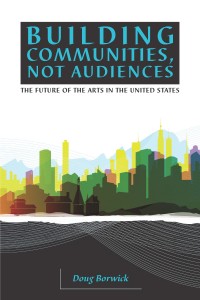 Available Formats:
Available Formats:
Paperback-Order Here
Ebook-Kindle, Nook, available at iBookstore (using iBook app)
For information on bulk purchases (≥ 10), click here
Building Communities, Not Audiences: The Future of the Arts in the U.S., written and edited by Doug Borwick, holds that established arts organizations, for practical and moral reasons, need to be more deeply connected to their communities. It serves as an essential primer for any member of the arts community–artist, administrator, board member, patron, or friend–who is interested in the future of the arts. It also provides new ways of looking at the arts as a powerful force for building better communities and improving the lives of all.
It is from community that the arts developed
and it is in serving communities that the arts will thrive . . .
Communities do not exist to serve the arts;
the arts exist to serve communities.
Building Communities, Not Audiences identifies the factors that serve to isolate established arts organizations from their communities, points out the trends that loom as imminent threats to the long-term viability of the artistic status quo, and presents principles and mechanisms whereby arts organizations can significantly extend their reach into the community, supporting enhanced sustainability. Included are case studies and examples of successful community engagement work being conducted by arts organizations from around the U.S. Twenty-three contributors, representing chamber music, dance, museums, opera, orchestras, and theatre as well as an array of arts administration perspectives provide breadth of coverage.
The economic, social, and political environments out of which the infrastructure for Western ‘high arts’ grew have changed. Today’s major arts institutions, products of that legacy, no longer benefit from relatively inexpensive labor, a nominally homogeneous culture, or a polity openly managed by an elite class. Expenses are rising precipitously and competition for major donors is increasing; as a result, the survival of established arts organizations hinges on their ability to engage effectively with a far broader segment of the population than has been true to date.
See also: Engage Now! A Guide to Making the Arts Indispensable
——————————
From the Foreword by Rocco Landesman, Chairman, National Endowment for the Arts:
“I think the days of the arts in ivory towers are behind us; the very best arts organizations are . . . connecting communities with artists . . . . Not only can the arts build communities, I think we must.”
From the Foreword by Robert L. Lynch, President and CEO, Americans for the Arts:
“Doug Borwick calls for substantive rather than superficial efforts, authentic and systemic changes. . . . The challenge is not whether to build communities or audiences but how to build communities and audiences together.”
——————————
Contributors:
Barbara Schaffer Bacon: Co-Director, Animating Democracy
Sandra Bernhard: Director, HGOco, Houston Grand Opera
Susan Badger Booth: Professor, Eastern Michigan University
Tom Borrup: Principal, Creative Community Builders
Ben Cameron: Program Director for the Arts, Doris Duke Charitable Foundation
William Cleveland: Director, Center for the Study of Art and Community
Lyz Crane: Community Development Consultant
David Dombrosky: CMO, InstantEncore
Maryo Gard Ewell: Community Arts Consultant
Tom Finkelpearl: Executive Director, Queens Museum of Art
Pam Korza: Co-Director, Animating Democracy
Denise Kulawik: Principal, Oneiros, LLC, andDevelopment Consultant to Pillsbury House Theatre
Helen Lessick: Artist and Civic Art Advocate
Dorothy Gunther Pugh: Founder & Artistic Director, Ballet Memphis
Stephanie Moore: Arts and Culture Researcher
Diane Ragsdale: Cultural Critic, Speaker, Writer
Noel Raymond: Co-Director, Pillsbury House Theatre, St. Paul, MN
Preranna Reddy: Director of Public Events, Queens Museum of Art
Sebastian Ruth: Founder & Artistic Director, Community MusicWorks, Providence, RI
Russell Willis Taylor: President and CEO, National Arts Strategies
James Undercofler: Professor, Drexel University; former President and CEO, Philadelphia Orchestra
Roseann Weiss: Director, CAT Institute, Regional Arts Commission, St. Louis, MO
